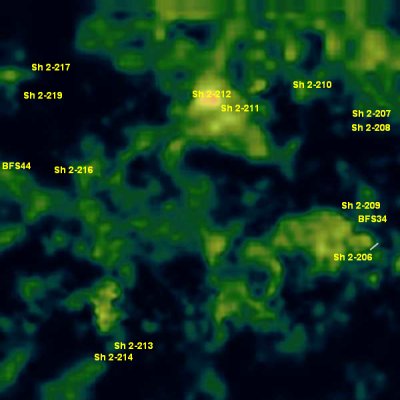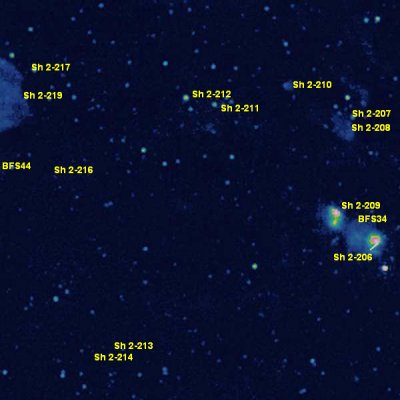
The often great differences in emission from different objects are very visible in this sector. Sh 2-211 and Sh 2-212 are most prominent at microwave frequencies.
Source: Galactic Plane Explorer microwave image
The Auriga gap of low emission continues into the sector and extends into the constellation Perseus. Two young and well studied [1], [2] HII regions are visible in the Auriga gap at a distance of about 4 to 5 thousand parsecs: Sh 2-217 and Sh 2-219. Both appear to be ionised by single hot stars surrounded by cooler infrared clusters. The ionising star is likely of class B0V for Sh 2-219 and a slightly brighter O9V star for Sh 2-217. Sh 2-217 is about twice as large as Sh 2-119 and is accompanied by a 4100 solar mass molecular cloud. There is very little gas associated with Sh 2-119. [1]
The planetary nebula Sh 2-216 is nearby (120 parsecs) and very old (at least 500 thousand years). [3]
Sh 2-213 appears to be a very faint Stromgren sphere around a B4 class star in the cluster Berkeley 11. [4] There is no visible emission around either Sh 2-213 or Sh 2-214 on any of the frequency maps.
The Auriga gap ends with the molecular cloud complex (or complexes), visible in microwaves in the outer Milky Way, that contains the HII regions Sh 2-211 and Sh 2-212. Sh 2-212 contains the star cluster NGC 1624 [5] and appears to be ionised by two stars - one O6 I and the other B1 III.[6] A recent study has found that NGC 1624 is 4 million years old and lies at a distance of 6000 parsecs. [7] Sh 2-211 appears to share the same giant molecular cloud as Sh 2-212[5] and thus probably has a similar distance, although distances as high as 7800 parsecs have been suggested. [6] It appears to be ionised by three stars of the classes O9 Ib, O9 V and B0 V. [6]
There is, remarkably, nothing significant in the scientific literature on the HII region Sh 2-210, despite its large size in hydrogen-alpha and visibility (albeit on a much smaller scale) at radio and infrared frequencies as well. Russeil ventures a distance estimate of 2200 parsecs [8], which would give this mysterious nebula in the direction of the constellation Camelopardalis a diameter of 12.8 parsecs. Sh 2-210 lies behind the far eastern end of Cam OB1, the largest OB association, which stretches 17 degrees in longitude from 151° all the way to 134°.

Sh 2-206 and Sh 2-209 are most prominent at radio frequencies.
Source: Galactic Plane Explorer radio image
Cam OB1 and the related Camelopardalis molecular cloud complex, lie at a distance of 800 to 1000 parsecs. They mark the outer boundary of our local galactic region, the Orion spur, just as similar molecular clouds in Auriga, Gemini, Monoceros and Canis Majoris mark this boundary east of the Auriga gap.
The much smaller HII regions Sh 2-207 and Sh 2-208 appear behind Sh 2-210. Sh 2-207 is so round that it looks like a planetary nebula. It is located at a distance of about 3400 parsecs and is ionised by an O9 IV class star. [5] Sh 2-208 contains the optical star cluster Waterloo 1 as well as the loose infrared cluster [BDS2003] 64. [9]
Further south is a significant molecular cloud complex associated with the HII and star formation region Sh 2-209 [10], [11], which harbours the infrared star cluster [BDS2003] 65 at a distance of about 4900 parsecs. [9] BFS 34 is nearby in the sky and also contains its own infrared cluster - [BDS2003] 63. [9]
Sh 2-206 (NGC 1491) is an older, evolved HII region ionised by the O5 star BD +50 886 [12] and bright at hydrogen-alpha, radio and infrared frequencies. You can see a good image of this nebula in visible light here which shows the bubble formed around the central star.
Nebulae in this sector
Notes
1. ^ Deharveng, L., Zavagno, A., Salas, L., Porras, A., Caplan, J., & Cruz-González, I. 2003, Astronomy and Astrophysics, Sequential star formation at the periphery of the H II regions Sh 217 and Sh 219
2. ^ Leahy, D. A. 2002, Journal of the Royal Astronomical Society of Canada, A Multi-Wavelength Study of the H II Region Sharpless 217
3. ^ Tweedy, R. W., Martos, M. A., & Noriega-Crespo, A. 1995, Astrophysical Journal, The Closest Planetary Nebula, SH 2-216, and Its Interaction with the Interstellar Medium
4. ^ Jackson, P. D., Fitzgerald, M. P., & Moffat, A. F. J. 1980, Astronomy and Astrophysics Supplement Series, Photoelectric UBV observations of the open cluster Berkeley 11
5. ^ Pismis, P., Hasse, I., & Quintero, A. 1991, Publications of the Astronomical Society of the Pacific, A comparative study of morphology and velocity field of the emission nebulae S153, S207, S211, S212, and A71
6. ^ Chini, R. & Wink, J. E. 1984, Astronomy and Astrophysics, The galactic rotation outside the solar circle
7. ^ Sujatha, S. & Babu, G. S. D. 2006, Astrophysics and Space Science, NGC 1624 (OCl 403, Cr 53) A very young open cluster
8. ^ Russeil, D. 2003, Astronomy and Astrophysics, Star-forming complexes and the spiral structure of our Galaxy
9. ^ Bica, E., Dutra, C. M., Soares, J., & Barbuy, B. 2003, Astronomy and Astrophysics, New infrared star clusters in the Northern and Equatorial Milky Way with 2MASS
10. ^ Ghosh, S. K., Mookerjea, B., Rengarajan, T. N., Tandon, S. N., & Verma, R. P. 2001, Bulletin of the Astronomical Society of India, Far infrared mapping of three galactic star forming regions
11. ^ Omar, A., Chengalur, J. N., & Roshi, D. A. 2002, Bulletin of the Astronomical Society of India, The electron temperatures of HII regions S 201, S 206 and S 209: multi-frequency GMRT observations.
12. ^ Deharveng, L., Israel, F. P., & Maucherat, M. 1976, Astronomy and Astrophysics, Optical and radio observations of the galactic H II region S 206 /NGC 1491/












